Archived - HIV screening and testing in Canada—Part 1

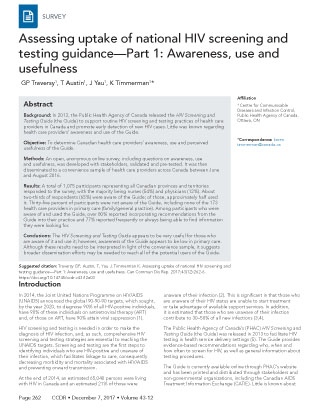 Download this article as a PDF (382 KB - 5 pages)
Download this article as a PDF (382 KB - 5 pages) Published by: The Public Health Agency of Canada
Issue: Volume 43-12: Can we eliminate HIV?
Date published: December 7, 2017
ISSN: 1481-8531
Submit a manuscript
About CCDR
Browse
Volume 43-12, December 7, 2017: Can we eliminate HIV?
Survey
Assessing uptake of national HIV screening and testing
guidance—Part 1: Awareness, use and usefulness
GP Traversy1, T Austin1, J Yau1, K Timmerman1
Affiliation
1 Centre for Communicable Diseases and Infection Control, Public Health Agency of Canada, Ottawa, ON
Correspondence
Suggested citation
Traversy GP, Austin, T, Yau J, Timmerman K. Assessing uptake of national HIV screening and testing guidance—Part 1: Awareness, use and usefulness. Can Commun Dis Rep. 2017;43(12):262-6. https://doi.org/10.14745/ccdr.v43i12a03
Abstract
Background: In 2013, the Public Health Agency of Canada released the HIV Screening and Testing Guide (the Guide) to support routine HIV screening and testing practices of health care providers in Canada and promote early detection of new HIV cases. Little was known regarding health care providers' awareness and use of the Guide.
Objective: To determine Canadian health care providers' awareness, use and perceived usefulness of the Guide.
Methods: An open, anonymous online survey, including questions on awareness, use and usefulness, was developed with stakeholders, validated and pre-tested. It was then disseminated to a convenience sample of health care providers across Canada between June and August 2016.
Results: A total of 1,075 participants representing all Canadian provinces and territories responded to the survey, with the majority being nurses (54%) and physicians (12%). About two-thirds of respondents (65%) were aware of the Guide; of those, approximately half used it. Thirty-five percent of participants were not aware of the Guide, including none of the 173 health care providers in primary care (family/general practice). Among participants who were aware of and used the Guide, over 80% reported incorporating recommendations from the Guide into their practice and 77% reported frequently or always being able to find information they were looking for.
Conclusions: The HIV Screening and Testing Guide appears to be very useful for those who are aware of it and use it; however, awareness of the Guide appears to be low in primary care. Although these results need to be interpreted in light of the convenience sample, it suggests broader dissemination efforts may be needed to reach all of the potential users of the Guide.
Introduction
In 2014, the Joint United Nations Programme on HIV/AIDS (UNAIDS) announced the global 90-90-90 targets, which sought, by the year 2020, to diagnose 90% of all HIV-positive individuals, have 90% of these individuals on antiretroviral therapy (ART) and, of those on ART, have 90% attain viral suppressionFootnote 1.
HIV screening and testing is needed in order to make the diagnosis of HIV infection, and, as such, comprehensive HIV screening and testing strategies are essential to reaching the UNAIDS targets. Screening and testing are the first steps to identifying individuals who are HIV-positive and unaware of their infection, which facilitates linkage to care, consequently decreasing morbidity and mortality associated with HIV/AIDS and preventing onward transmission.
At the end of 2014, an estimated 65,040 persons were living with HIV in Canada and an estimated 21% of those were unaware of their infectionFootnote 2. This is significant in that those who are unaware of their HIV status are unable to start treatment or take advantage of available support services. In addition, it is estimated that those who are unaware of their infection contribute to 30-50% of all new infectionsFootnote 3 Footnote 4.
The Public Health Agency of Canada's (PHAC) HIV Screening and Testing Guide (the Guide) was released in 2013 to facilitate HIV testing in health service delivery settingsFootnote 5. The Guide provides evidence-based recommendations regarding who, when and how often to screen for HIV, as well as general information about testing procedures.
The Guide is currently available online through PHAC's website and has been printed and distributed through stakeholders and non-governmental organizations, including the Canadian AIDS Treatment Information Exchange (CATIE). Little is known about health care providers' awareness and use of the Guide, and whether the Guide is useful to health care providers.
This article describes the results of Part 1 of a larger study assessing the uptake of the Guide. The objective of Part 1 was to evaluate the awareness, use and perceived usefulness of the Guide. The objective of Part 2 was to assess health care providers' knowledge, comfort and clinical practices related to HIV testingFootnote 6. The overall study is part of the work underway to inform potential updates of the Guide to support HIV screening and testing practices in Canada.
Methods
Information related to health care providers' awareness and use of the Guide were collected over a three month period (June–August 2016) as part of a larger anonymous online survey. The Checklist for Reporting Results of Internet E-Surveys was followed where applicable for the reporting of methodology and resultsFootnote 7. The study was approved by the Health Canada and PHAC Research Ethics Board.
Survey design
The survey was designed in consultation with evaluation, infectious disease and HIV content experts. The design was based on previous PHAC surveys with similar objectives, previous literature on survey design, factors that influence testing behaviour and known barriers and facilitators of testingFootnote 8 Footnote 9 Footnote 10 Footnote 11 Footnote 12. The survey and study protocol were externally peer-reviewed for face validity by an infectious disease physician and an expert in evaluation. Pilot testing of the questionnaire was then conducted with a panel of infectious disease experts prior to full-scale dissemination.
Awareness was assessed by asking participants whether they were aware of the Guide. Those who indicated being aware of the Guide were asked to identify the method (e.g., by email, word-of-mouth, PHAC's website or receiving a print copy of the Guide). Use was assessed by asking participants whether they had used the Guide. If respondents indicated having used the Guide ("users"), they were then asked to report on how often they used it. "Non-users" were defined as those who had not used the Guide, and may or may not have been aware of it. Usefulness was assessed by asking participants how often they were able to find the information they were looking for in the Guide, whether they identified any errors or out of date material in the Guide and whether they regularly incorporated recommendations from the Guide into clinical practice. Further details on these variables, as well as the full survey, are available upon request.
Recruitment and administration
Participants were recruited to the voluntary survey via a link attached to a bilingual (English and French) email invitation sent to online newsletters/listservs and CATIE. Participants were also recruited by email invitations distributed by contacts of other Government of Canada departments and regional offices. A link to the survey was also sent to 23 associations for health professionals (e.g., physicians, nurses, social workers and community-based service providers). While only three of the professional associations agreed to disseminate the survey (Pacific AIDS Network, Canadian Public Health Association and Canadian AIDS Society), others may have disseminated the survey to their members without informing the research team. Individuals who received the survey via e-mail or newsletter may have also further disseminated the survey among their colleagues and networks so a participation rate cannot be calculated.
The survey was hosted on the Canadian Network for Public Health Intelligence Web Data online surveying tool and was available in English and French. Respondents were provided information related to privacy and data management/storage, length of the survey, purpose of the study and contact information for the principle investigator, prior to providing informed consent to participate. Participation was not incentivized. Participants' responses were included if they were 18 years of age or older, currently practicing and represented health care providers/professionals.
Data management and analysis
Survey responses were collected in a secure electronic database and then downloaded to a password-protected Microsoft Excel file. Responses were anonymous with no personal identifiers collected (e.g., names, addresses, email addresses or IP addresses). Descriptive statistics were used to calculate response frequencies. Analyses were completed using Microsoft Excel.
Results
In total, 1,075 health care providers completed the survey. Survey respondents self-identified from all 13 provinces and territories, with the majority from Ontario, British Columbia and Quebec (Table 1). The majority of respondents were nurses (54%), with physicians (12%) representing the second most common provider type.
| Demographics | n | % |
|---|---|---|
| Province/territory of practice (n=1,069) | ||
| Ontario | 375 | 35.1 |
| British Columbia | 152 | 14.2 |
| Quebec | 149 | 13.9 |
| Saskatchewan | 107 | 10 |
| Manitoba | 91 | 8.5 |
| Alberta | 79 | 7.4 |
| New Brunswick | 30 | 2.8 |
| Nova Scotia | 29 | 2.7 |
| Newfoundland and Labrador | 22 | 2.1 |
| Northwest Territories | 14 | 1.3 |
| Prince Edward Island | 11 | 1.1 |
| Yukon | 7 | 0.7 |
| Nunavut | 3 | 0.3 |
| Type of provider (n=1,071) | ||
| Nurse | 577 | 53.9 |
| Physician | 127 | 11.9 |
| Community health worker | 95 | 8.9 |
| Nurse practitioner | 84 | 7.8 |
| Social worker | 52 | 4.9 |
| Counsellor | 39 | 3.6 |
| Midwife | 8 | 0.7 |
| Medical resident | 0 | 0 |
| Other health care provider | 89 | 8.3 |
| Area of practice (n=1,055) | ||
| STI/Public Health | 455 | 43.1 |
| Family/General practice | 173 | 16.4 |
| Specialist | 114 | 10.8 |
| Emergency/Urgent care | 27 | 2.6 |
| Other (please specify) | 286 | 27.1 |
| Setting (n=1,061) | ||
| Large urban population centre (100,000+) | 564 | 53.2 |
| Medium population centre (between 30,000 and 99,999) | 181 | 17.1 |
| Small population centre (between 1,000 and 29,999) | 234 | 22.1 |
| Rural area (<1,000) | 62 | 5.8 |
| Geographically isolated/remote (not accessible by road or only by a dirt/winter road) | 20 | 1.9 |
| Years of practice (n=1,069) | ||
| > 20 years | 409 | 38.3 |
| 15 – 19 years | 141 | 13.2 |
| 10 – 14 years | 149 | 13.9 |
| 5 – 9 years | 177 | 16.6 |
| < 5 years | 193 | 18.1 |
|
Abbreviation: n, number Note: Sample sizes varied between n=1055-1071 as individual questions were voluntary |
||
Most respondents (43%) worked in the area of sexually transmitted infections (STIs) and public health. Over 25% of respondents indicated that their primary area was 'other,' such as corrections, health promotion and public health. Family/general practice (16%), specialist (10%) and emergency/urgent care (3%) made up the remainder of the responses (Table 1). The majority of participants practiced in large urban population centres (53%). More than a third of providers had been practicing for more than 20 years (Table 1).
Awareness
Approximately two-thirds of participants were aware of the Guide and, of those, half had used it (Figure 1). Nurses were the most aware of the Guide and health care providers who had been practicing for longer periods of time were more likely to be aware of the Guide. None of the health care providers who primarily practice in family/general care reported being aware of the Guide.
Figure 1: Percentage of respondents who are aware of and who use the Guide (n=1071)
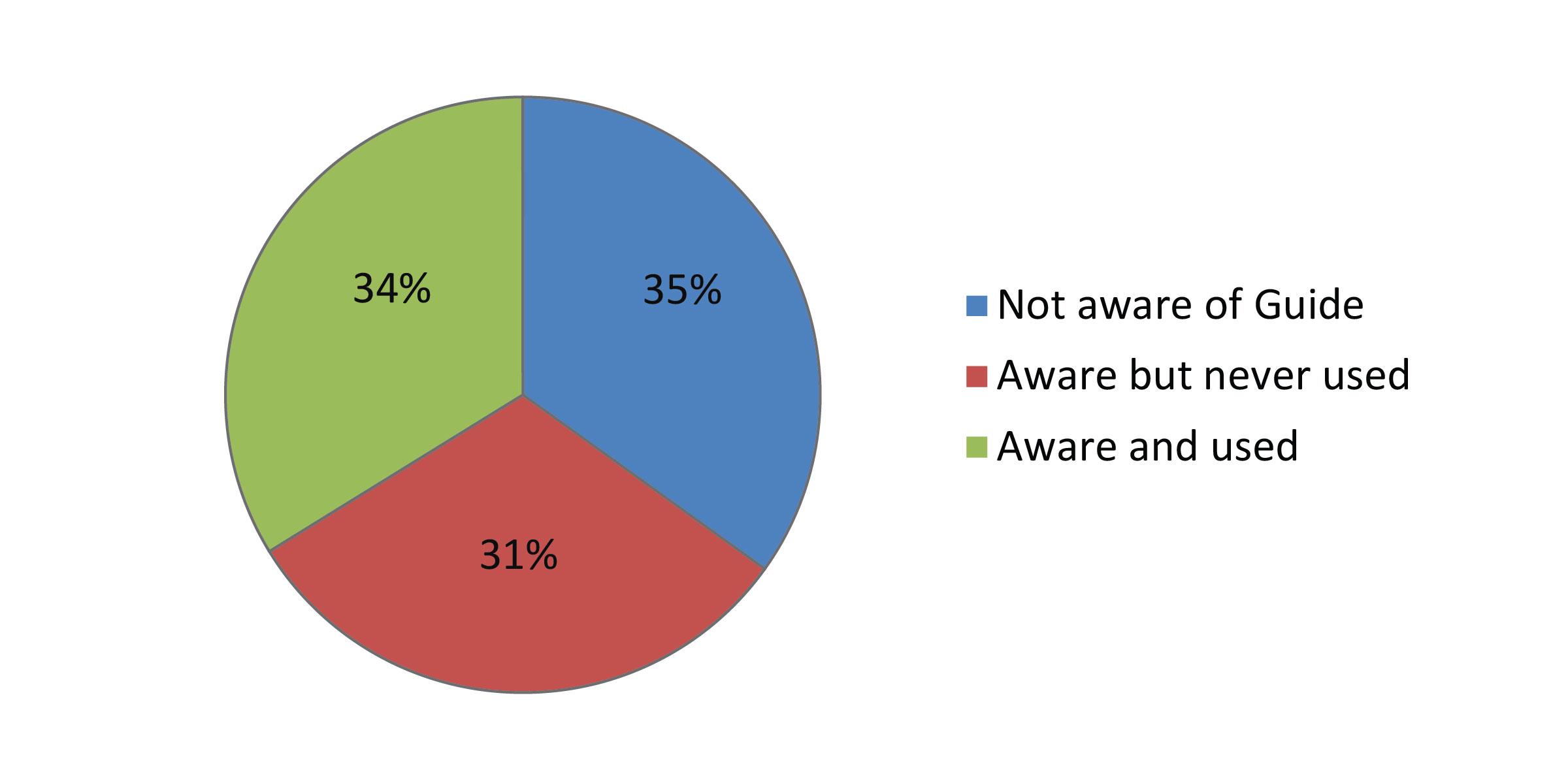
Text description: Figure 1
Figure 1: Percentage of respondents who are aware of and who use the Guide (n=1071)
| Level of awareness | Percentage of respondents |
|---|---|
| Not aware of Guide | 35% |
| Aware but never used | 31% |
| Aware and used | 34% |
The most common ways of becoming aware of the Guide were via e-mail from PHAC (34%), a colleague (26%) or the PHAC website (22%) (Figure 2).
Figure 2: How respondents became aware of the Guide (n=696)
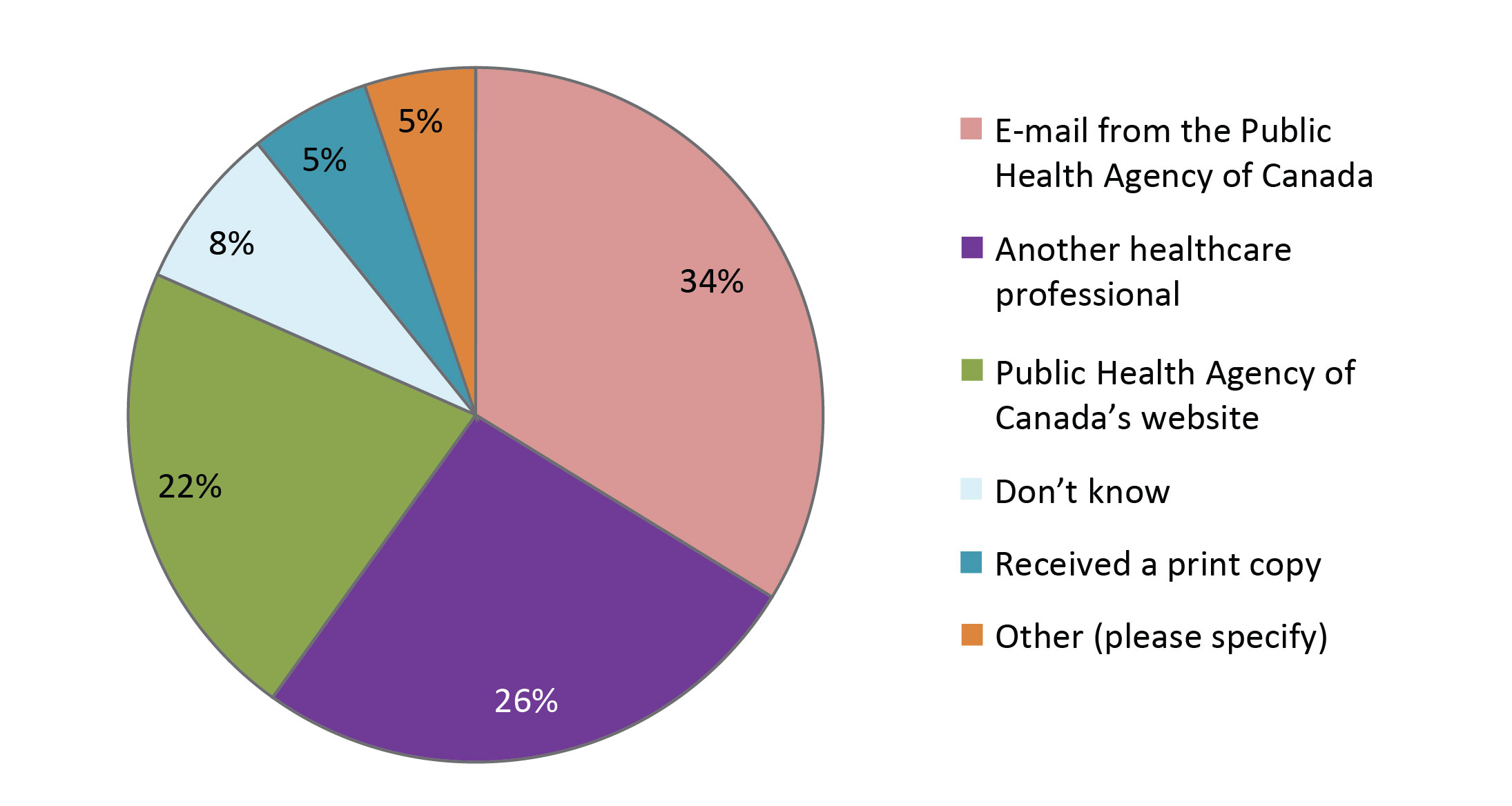
Text description: Figure 2
Figure 2: How respondents became aware of the Guide (n=696)
| How respondents became aware of the Guide | Percentage of respondents |
|---|---|
| E-mail from the Public Health Agency of Canada | 34% |
| Another healthcare professional | 26% |
| Public Health Agency of Canada's website | 22% |
| Don't know | 8% |
| Received a print copy | 5% |
| Other (please specify) | 5% |
Use
Of 359 users of the Guide, 16% reported using the Guide frequently (at least once a month), 28% reported occasional use of the Guide (once every two to three months), 35% reported rare use of the Guide (once every four to six months) and 21% reported very rare use of the Guide (less than once a year) and 0.3% reported never having used the Guide (Figure 3). Because they were not aware of the Guide, no health care providers in family/general practice had used it.
Figure 3: Frequency of use of the Guide by those who indicated having used it (n=359)
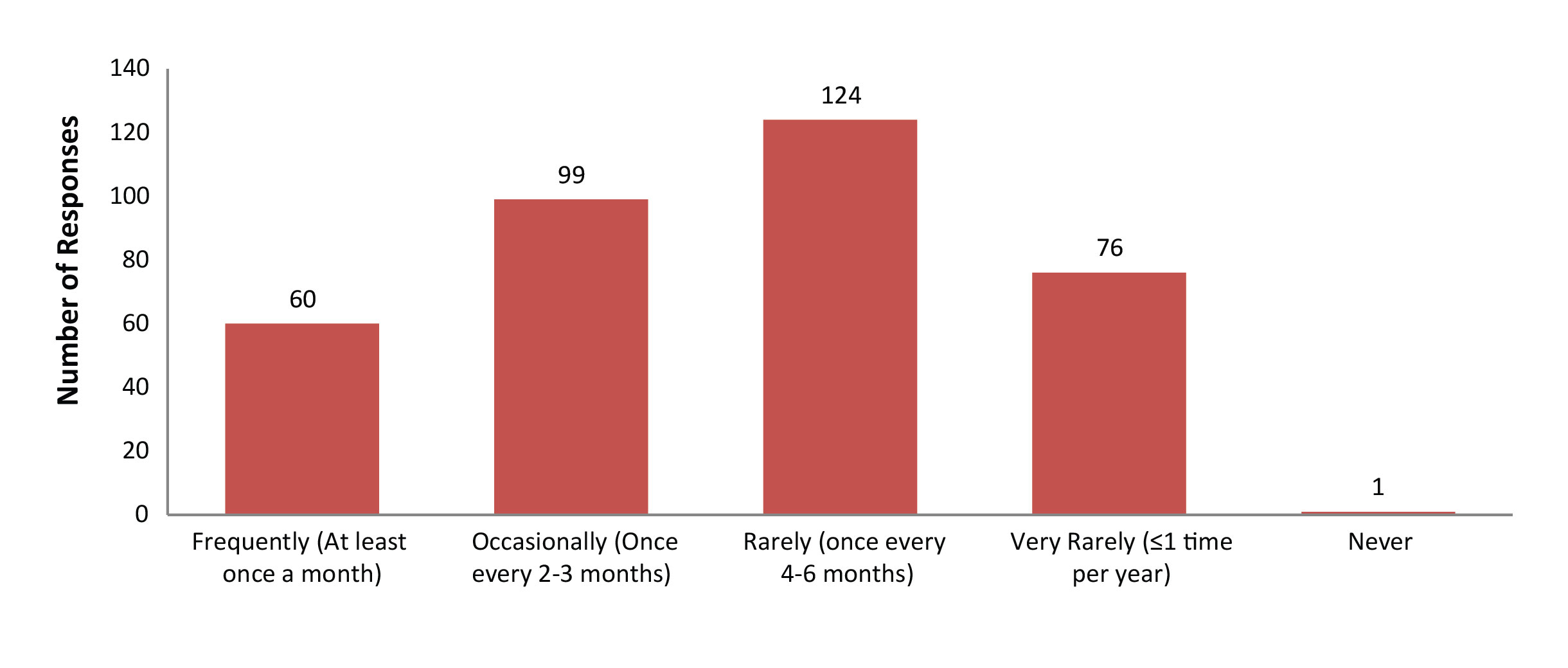
Text description: Figure 3
Figure 3: Frequency of use of the Guide by those who indicated having used it (n=359)
| Frequency of use of the Guide by those who indicated having used it | Number of respondents |
|---|---|
| Frequently (At least once a month) | 60 |
| Occasionally (Once every 2-3 months) | 99 |
| Rarely (once every 4-6 months) | 124 |
| Very Rarely (≤1 time per year) | 76 |
| Never | 1 |
| Total | 359 |
Usefulness
Of those who used the guide, the majority (84%) reported that they regularly incorporated recommendations from the Guide in their practice. Most users (77%) indicated being able to find the information they were looking for at least 75% of the time (Figure 4). Only 13 users (3.6%) reported finding errors or out-of-date material in the Guide. This included concerns about the practicality and conciseness of the Guide and the need to update the Guide with respect to new technologies, such as point-of-care testing and pre-exposure prophylaxis (PrEP).
Figure 4: How often users of the Guide are able to find the information they were looking for when using it (n=358)
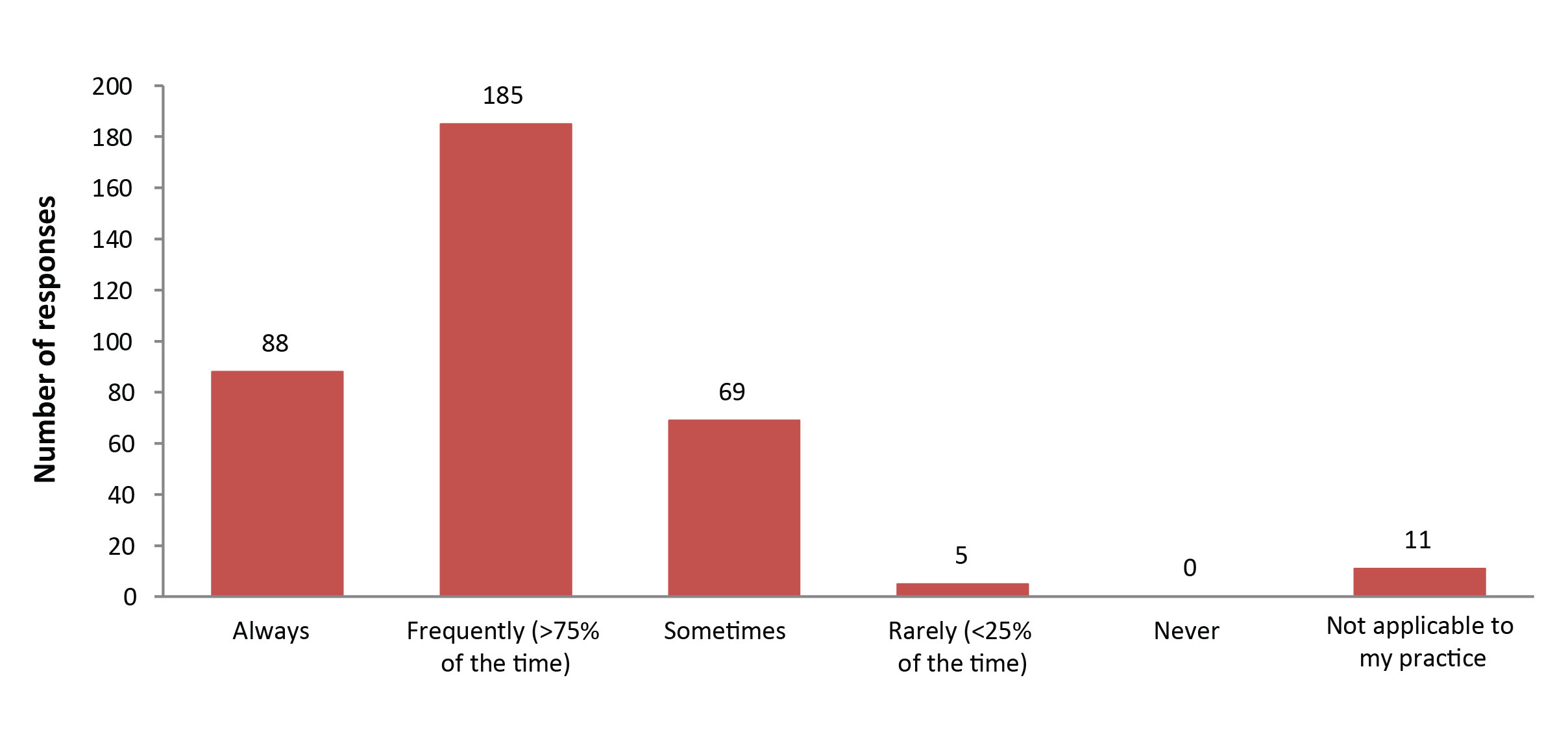
Text description: Figure 4
Figure 4: How often users of the Guide are able to find the information they were looking for when using it (n=358)
| How often can you find the info you are looking for in the Guide? | Number of respondents |
|---|---|
| Always | 88 |
| Frequently (>75% of the time) | 185 |
| Sometimes | 69 |
| Rarely (<25% of the time) | 5 |
| Never | 0 |
| Not applicable to my practice | 11 |
Discussion
Overall, the results of this national survey suggest that health care providers have only moderate awareness of PHAC's HIV Screening and Testing Guide but those who had, reported that they regularly incorporated recommendations from the Guide in their practice. It was noted that in a few areas, improvements could be made in the practicality/conciseness of the Guide and incorporating information on new prevention technologies such as PrEP would be useful.
Awareness may have been impacted by the dissemination methods used when first distributing the Guide. Email, the PHAC website and word-of-mouth appear to be effective knowledge dissemination methods as many respondents indicated that they learnt about the Guide through these routes, but our avenues of dissemination may have been more likely to target health care providers in the area of sexual health who would be more comfortable with HIV testing than other health care providers.
The strengths of the current study include the geographically representative sample, with respondents from all provinces and territories, and the diverse range of health care providers. Moreover, the survey was comprehensive, covering a number of areas that could be used to update the Guide.
Limitations include the use of a convenience sample, so that the participants may not be representative of all health care providers in Canada and it is not possible to generalize the results to all practitioners in Canada. This may have been particularly true of primary care health care providers. Moreover, the use of self-reported measures with respect to use of the Guide could have been subject to recall bias.
Conclusion
Awareness of the PHAC's HIV Screening and Testing Guide among health care providers could be improved. Although the current results need to be interpreted in light of the convenience sample, it suggests broader dissemination efforts to reach all of the potential users of the Guide may be needed as part of the overall effort to eliminate HIV in Canada.
Authors' statement
GT—conceptualization, methodology, data collection and curation, formal analysis, writing—original draft, writing—review and editing, supervision, project administration
TA—methodology, data collection and curation, writing—original draft, writing—review and editing
JY—methodology, data collection and curation, writing—original draft, writing—review and editing
KT—conceptualization, methodology, writing—original draft, writing—review and editing, supervision, project administration
Conflict of interest
None.
Contributors
The authors would like to thank the following individuals, in no particular order, for their contribution to this manuscript:
Kelsey Young—formal analysis
Shalane Ha—methodology, reviewing and editing
Jun Wu—methodology, writing—reviewing and editing, project administration
Margaret Gale-Rowe—methodology, writing—reviewing and editing, project administration
Makenzie Weekes—writing—reviewing and editing
Priya Prabhakar—writing—reviewing and editing
Militza Zencovich—methodology
Kanchana Amaratunga—methodology
Courtney Smith—formal analysis
Mandip Maheru—methodology
Ulrick Auguste—methodology
Katie Freer—methodology
Dena Schanzer—methodology, formal analysis
Mary Lysyk—methodology
Katherine Dinner—methodology
Simon Foley—conceptualization, methodology
Acknowledgements
The authors would like to acknowledge the input provided by the various contributors throughout the various stages of the project on the survey design, Research Ethics Board submissions, data collection, analysis, and interpretation. Thank you to the team at the Canadian Network for Public Health Intelligence for their help in setting up the survey tool, and to the Health Canada Research Ethics Board. The authors would also like to thank the Expert Working Group of the Canadian Guidelines on Sexually Transmitted Infections for the help with pilot testing the survey, and the various organizations that helped disseminate the survey.
Funding
The authors have no sources of external funding to declare. This research was supported by the Public Health Agency of Canada.